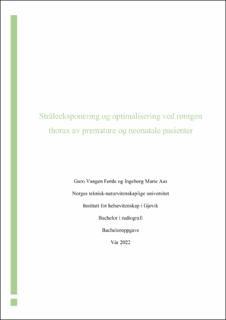| dc.contributor.advisor | Berntsen, Astrid | |
| dc.contributor.author | Førde, Guro Vangen | |
| dc.contributor.author | Aas, Ingeborg Marie | |
| dc.date.accessioned | 2022-07-08T17:19:16Z | |
| dc.date.available | 2022-07-08T17:19:16Z | |
| dc.date.issued | 2022 | |
| dc.identifier | no.ntnu:inspera:106254365:110807182 | |
| dc.identifier.uri | https://hdl.handle.net/11250/3004120 | |
| dc.description.abstract | Problemstilling: Hvilke faktorer bidrar til økt stråledose ved røntgen thorax av premature og neonatale pasienter innlagt på intensivavdeling, og hvordan kan disse optimaliseres for å opprettholde prinsippet om ALARA?
Hensikt: Hensikten med oppgaven er å belyse hvilke faktorer som har en innvirkning på bidrag til stråledose hos premature og neonatale pasienter ved røntgen thorax, og tiltak som kan gjennomføres for å optimalisere stråledosen til denne pasientgruppen.
Metode: Det er benyttet litteraturstudie som metode for å besvare problemstillingen. Syv studier danner grunnlaget for en analysering av hvilke faktorer som bidrar til økt stråledose ved røntgen thorax og hvilke tiltak som kan optimaliseres for å redusere stråledosen. Faktorene i denne oppgaven er: kV, mAs, kollimering, filtrering, antall røntgenbilder, detektorplassering og mangel på standardiserte protokoller.
Resultat: kV, mAs og kollimeringsfelt utgjorde de største faktorene som bidro til økt stråledose hos premature og neonatale pasienter. Filtrering, antall røntgenbilder og detektorplassering innvirket også på stråledosen, men ikke i like stor grad. For å optimalisere undersøkelsene og redusere dose fremkommer det at utarbeiding av standardiserte protokoller for lavere og flere vektklasser er nødvendig. Ultralyd kan være et nyttig hjelpemiddel for å skjerme pasientgruppen mot stråleeksponering i tillegg til god opplæring av personell.
Konklusjon: kV- og mAs-verdier burde optimaliseres for flere vektklasser. De fleste pasientene var overeksponert grunnet store kollimeringsfelt som strakk seg utenfor interesseområde. En reduksjon i strålefelt, vil bidra til å redusere og optimalisere stråledosen. Det burde tilstrebes å benytte filter, redusere antall røntgenbilder og plassere pasienten direkte på detektor der det er mulig. Mangel på standardiserte protokoller er en viktig faktor som bidrar til økt stråledose, og burde forskes nærmere på for å optimalisere stråledosen i henhold til ALARA-prinsippet.
Nøkkelord: prematur, neonatal, røntgen thorax, kollimering, stråledose, optimalisering
Antall ord: 9990 | |
| dc.description.abstract | Thesis: Which factors contribute to an increase in radiation dose in chest x-rays to premature and neonatal NICU-patients, and how can these be optimized to maintain the principle of ALARA?
Purpose: The purpose of this literature review is to determine which factors contribute to an increase in radiation dose in chest x-rays to premature and neonatal NICU-patients, and how these can be optimized among this patient group.
Method: A literature review has been used to answer the thesis question. Seven studies were used to investigate which factors contributed to an increase in the radiation dose in chest x-rays and how these can be optimized. The factors in this review are defined as: kV, mAs, collimation, filtration, number of x-rays, detector placement and a lack of standardized protocols.
Results: kV, mAs and the size of the collimation-field are the main factors that contributed to an increased radiation dose in premature and neonatal patients. Filtration, number of x-rays and detector placement also contributed to the dose, but not to the same extent. To optimize the examinations and reduce the radiation dose, standardized protocols with lower and additional weight-groups are highly necessary. Ultrasound can be a useful modality to shield the patient group to radiation in total, and appropriate training of personnel is important.
Conclusion: kV and mAs values should be optimized for additional weight groups. Most patients were overexposed due to collimation fields exceeding areas of interest. A reduction in field size will contribute to reduce and optimize the radiation dose. Efforts should be made to use filters, reduce the number of x-rays per patient and place the patient directly on the image receptor, when possible. Lack of standardized protocols are an important factor that contributes to an increased radiation dose, and should be researched further in order to be optimized in accordance to the principle of ALARA.
Keywords: premature, neonatal, chest x-ray, collimation, radiation dose, optimization
Number of words: 9990 | |
| dc.language | nob | |
| dc.publisher | NTNU | |
| dc.title | Stråleeksponering og optimalisering ved røntgen thorax av premature og neonatale pasienter | |
| dc.type | Bachelor thesis | |
